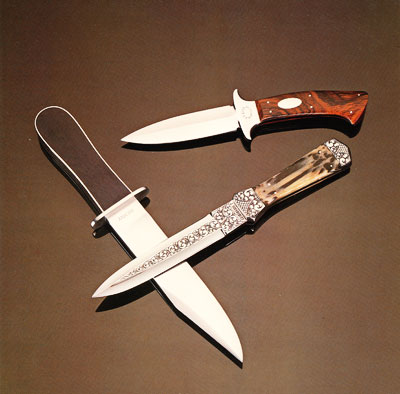|
|
Fighting Knives
Top: A spear-point boot knife by Jim Ence. The blade is 440-C steel, with an integral guard and tapered tang The handle is cocobolo wood with a nickle/silver inlay
Left: A Jackson model by Ed Henry. This style of small Bowie was popular in San Francisco during the Gold Rush days. The 6 1/2" blade is 440-C steel, the handle is African blackwood bound with nickle-silver. Henry's knives are entirely hand finished (he uses no buffing wheels) and are appreciating at 25% a year.
Right: A Sornberger spear-point boot dagger engraved by Mel Wood on both sides. The coffin-shaped handle
is Mouflan ram horn from Corsica; the flared bolsters are made of nickel-silver, and the blade is 154-CM. |
 |

Few people can heft a fighting knife without pondering the thin edge that separates life and death. A fighting knife has an unabashed intent, but, like the sleek grace of a jungle cat, it has its own innocent beauty.
When Jim Bowie killed Major Norris Wright in the infamous Mississippi Sand Bar Duel of 1827, he used a stout single-edged knife hand-made and given to him by his brother Rizon Bowie. From that grew the classic American Bowie, with part of the back edge of the blade curved down to the point and sharpened. The design wasn't really new; similar blades dating back to 800 A.D. have been unearthed.
But something about the man or the knife fired the imagination of pioneer America, and any big and deadly fighting blade of that style has been called a "Bowie Knife" ever since.
In the 1840's, Colt's revolver began to make knives obsolete as the preferred weapon for personal defense; even so, the fledgling American steel industry was swamped by the demand, and the knife factories of Sheffield, England grew rich making Bowies for America until after the Civil War, when improved domestic steels-and a tariff against imports- made factories here competitive.
A knifemaker's life would be simpler if there were one kind of steel that was best, but even today there are arguments. Sheffield's famous crucible steel had a high carbon content, made by a formula discovered in 1750 and kept secret. But it wasn't perfect.
A perfect steel would make a knife that would never rust, never snap, never need sharpening. The perfect combination of hardness, toughness (lack of brittleness), abrasion resistance, rust resistance and edge-holding ability has yet to be found.
440-C, a 1% carbon steel with high chrome content, is popular today. It resists rust and corrosion even under hard use, and takes a beautiful finish for display purposes. Other steels preferred by today's makers are 154-CM, which is tough and holds a great edge, but is difficult to sharpen, and D-2, which is hard and sharp but has a tendency to rust.
Knifemaking is a complex task. Most makers start with a rectangular blank of steel between l/8 and 1/4 of an inch thick, and cut it to rough shape with a heavy-duty band saw. Then steel is removed by grinding to the final shape. It isn't easy to grind bevels that meet on both sides, nor is it simple to grind an edge along a hot blade. Even fitting a handle to the tang requires half a dozen steps. The skills of polishing require exceptional care-too much pressure against the polishing wheel can change the line of the blade, and lack of patience means another blade in the scrap bin.
Then the knife must be heated and quench-tempered. The shock of the quick temperature change converts the coarse grain of the steel into a fine-grained structure of great strength and hardness. If the blade is not perfectly symmetrical, quenching may cause cracking or warping because of uneven surface stress. Knifemaking is a craft unforgiving of miscues.
|
 |
|